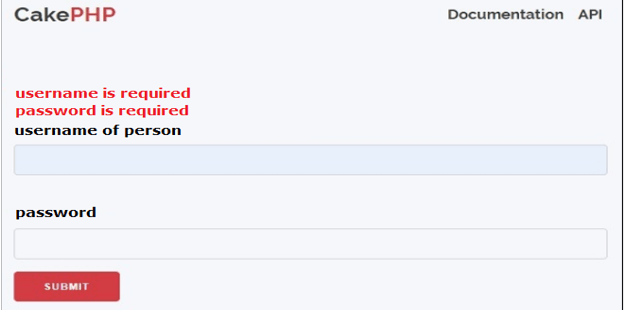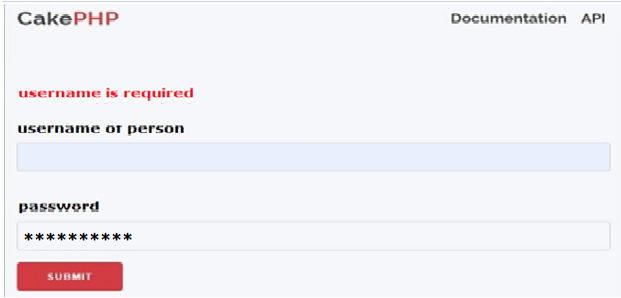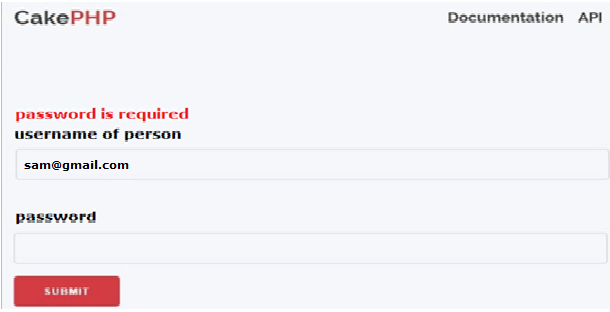CakePHP Validation
CakePHP is an open-source tool used to implement dynamic programming applications as well as it provides a different kind of functionality to the developer. Validation is one of the functionalities that is provided by the CakePHP, by using validation we can provide the validation to the arbitrary arrays of data as per our requirement. In CakePHP, we need to build the entities before the data validation in terms of shape and size. Here we also need to consider default entities, these entities will be validated before the conversation of entities. We can also apply validation rules as per our requirements.
Start Your Free Software Development Course
Web development, programming languages, Software testing & others
What is CakePHP Validation?
Information approval is a significant piece of any application, as it assists with ensuring that the information in a Model adjusts to the business rules of the application. For instance, you should ensure that passwords are somewhere around eight characters in length, or guarantee that usernames are special. Characterizing approval rules makes structure dealing with a whole lot simpler.
There are various perspectives to the approval cycle. What we’ll cover in this segment is the model side of things. Basically: what happens when you call the save () technique for your model. For more data about how to deal with the showing of approval blunders.
CakePHP Validation Methods
Now let’s see different validation methods in CakePHP as follows.
1. Add
Adds another standard to a field’s standard set. On the off chance that subsequent contention is a cluster, the rules list for the field will be supplanted with second contention and third contention will be overlooked.
Syntax
Add(string $specified field, array|string $specified name, array|Cake\Validation\ValidationRule $required rule [])
Explanation
In the above syntax, we use the add method with different parameters. In the above syntax specified name is used to define the name of the rule that we need to add. The array is used to define this rule or multiple rules as per requirement and this returns $this.
2. allowEmpty
By using this method, we can allow empty field
Syntax
allowEmpty(string $specified field, boolean|string|callable $whentrue, string|null msgull)
Explanation
In the above syntax, we use the add method with different parameters. In the above syntax specified name is used to define the name of the rule that we need to add. A boolean parameter is used to indicate when we empty we need to allow, here we can also validate in terms of true or false when we perform create or update operation. The message is used to show the message field and this returns $this.
3. Alphanumeric
By using this method, we can add alphanumeric rules to the field as per our requirements.
Syntax
alphanumeric (string $specified field, string|null $Msgnull, string|callable|null $whennull)
Explanation
In the above syntax, we use the alphanumeric method with different parameters. In the above syntax specified name is used to define the name of the rule that we need to add. Adds another standard to a field’s standard set. In the event that subsequent contention is a cluster, the rules list for the field will be supplanted with second contention and third contention will be overlooked and it returns $this.
4. Creditcard
By using this method, we can add credit card rules to the specified field as per requirement.
Syntax
creditCard(string $specified field , string $type'all', string|null $msgnull, string|callable|null $whennull)
Explanation
In the above syntax, we use the credit card method to add the rule with different parameters. The field you need to apply the standard to.
The sort of cards you need to permit. Defaults to ‘all’. You can likewise supply a variety of acknowledged card types, for instance, ‘mastercard’, ‘visa’, ‘amex’.
The mistake message when the standard falls flat. Either ‘make’ or ‘update’ or a callable that profits valid, when the approval rule ought to be applied and it returns $this.
5. Email
By using this method, we can add an email validation rule to the field as per our requirement.
Syntax
Email(string $specified field , boolean $checkMXfalse, string|null $msgnull, string|callable|null, $whennull)
Explanation
By using the above syntax, we can implement the email validation rule. The field you need to apply the standard too.
Regardless of whether to check the MX records.
The blunder message when the standard fizzles.
Either ‘make’ or ‘update’ or a callable that profits valid, when the approval rule ought to be applied.
6. maxLength
By using this method, we can apply string validation to the field.
Syntax
maxLength(string $specified field, integer $max, string|null $msgnull, string|callable|null $whennull)
Explanation
In the above syntax, we use the maxLength method with different parameters. Here the specified field is used to define the field to which we want to apply the rule, max is used to define the maximum length of string, msgnull is used to show an error message when the rule fails.
7. minLength
By using this method, we can apply string validation to the field.
Syntax
minLength(string $specified field, integer $min, string|null $msgnull, string|callable|null $whennull)
Explanation
In the above syntax, we use the minLength method with different parameters. Here the specified field is used to define the field which we want to apply the rule, min is used to define the minimum length of string, msgnull is used to show an error message when the rule fails.
How to Create CakePHP Validation?
Now let’s see how we can create CakePHP validation with examples as follows. First, we need to make the changes in routes.php file as follows.
<?php
use Cake\Http\Middleware\CsrfProtectionMiddleware;
use Cake\Routing\Route\DashedRoute;
use Cake\Routing\RouteBuilder;
$routes->setRouteClass(DashedRoute::class);
$routes->scope('/', function (RouteBuilder $builder) {
$builder->registerMiddleware('csrf', new CsrfProtectionMiddleware([
'httpOnly' => true,
]));
$builder->applyMiddleware('csrf');
//$builder->connect('/pages',['controller'=>'Pages','action'=>'display', 'home']);
$builder->connect('validation',['controller'=>'Valid','action'=>'index']);
$builder->fallbacks();
});
?>Now create an index.php file and write the following code as follows.
<?php
if($errors) {
foreach($errors as $error)
foreach($error as $mssg)
echo '<font color="red">'.$mssg.'</font><br>';
} else {
echo "There is no errors.";
}
echo $this->Form->create(NULL,array('url'=>'/validation'));
echo $this->Form->control('username of person');
echo $this->Form->control('password');
echo $this->Form->button('Submit');
echo $this->Form->end();
?>Now execute the above code we will get the following screen as shown below screenshot.

Suppose let’s consider, if we enter only password then it shows username is required as shown in the following screenshot.

Similarly, we can apply validation for username of person filed as shown in the following screenshot as follows.

In this way, we can implement different methods such as to get, post as per our requirement.
Conclusion
We hope from this article you learn more about the CakePHP validation. From the above article, we have taken in the essential idea of the CakePHP validation and we also see the representation and example of the CakePHP validation. From this article, we learned how and when we use the CakePHP validation.
The above is the detailed content of CakePHP Validation. For more information, please follow other related articles on the PHP Chinese website!

Hot AI Tools

Undresser.AI Undress
AI-powered app for creating realistic nude photos

AI Clothes Remover
Online AI tool for removing clothes from photos.

Undress AI Tool
Undress images for free

Clothoff.io
AI clothes remover

Video Face Swap
Swap faces in any video effortlessly with our completely free AI face swap tool!

Hot Article

Hot Tools

Notepad++7.3.1
Easy-to-use and free code editor

SublimeText3 Chinese version
Chinese version, very easy to use

Zend Studio 13.0.1
Powerful PHP integrated development environment

Dreamweaver CS6
Visual web development tools

SublimeText3 Mac version
God-level code editing software (SublimeText3)

Hot Topics
 1653
1653
 14
14
 1413
1413
 52
52
 1304
1304
 25
25
 1251
1251
 29
29
 1224
1224
 24
24
 PHP 8.4 Installation and Upgrade guide for Ubuntu and Debian
Dec 24, 2024 pm 04:42 PM
PHP 8.4 Installation and Upgrade guide for Ubuntu and Debian
Dec 24, 2024 pm 04:42 PM
PHP 8.4 brings several new features, security improvements, and performance improvements with healthy amounts of feature deprecations and removals. This guide explains how to install PHP 8.4 or upgrade to PHP 8.4 on Ubuntu, Debian, or their derivati
 Explain JSON Web Tokens (JWT) and their use case in PHP APIs.
Apr 05, 2025 am 12:04 AM
Explain JSON Web Tokens (JWT) and their use case in PHP APIs.
Apr 05, 2025 am 12:04 AM
JWT is an open standard based on JSON, used to securely transmit information between parties, mainly for identity authentication and information exchange. 1. JWT consists of three parts: Header, Payload and Signature. 2. The working principle of JWT includes three steps: generating JWT, verifying JWT and parsing Payload. 3. When using JWT for authentication in PHP, JWT can be generated and verified, and user role and permission information can be included in advanced usage. 4. Common errors include signature verification failure, token expiration, and payload oversized. Debugging skills include using debugging tools and logging. 5. Performance optimization and best practices include using appropriate signature algorithms, setting validity periods reasonably,
 How do you parse and process HTML/XML in PHP?
Feb 07, 2025 am 11:57 AM
How do you parse and process HTML/XML in PHP?
Feb 07, 2025 am 11:57 AM
This tutorial demonstrates how to efficiently process XML documents using PHP. XML (eXtensible Markup Language) is a versatile text-based markup language designed for both human readability and machine parsing. It's commonly used for data storage an
 Explain late static binding in PHP (static::).
Apr 03, 2025 am 12:04 AM
Explain late static binding in PHP (static::).
Apr 03, 2025 am 12:04 AM
Static binding (static::) implements late static binding (LSB) in PHP, allowing calling classes to be referenced in static contexts rather than defining classes. 1) The parsing process is performed at runtime, 2) Look up the call class in the inheritance relationship, 3) It may bring performance overhead.
 PHP Program to Count Vowels in a String
Feb 07, 2025 pm 12:12 PM
PHP Program to Count Vowels in a String
Feb 07, 2025 pm 12:12 PM
A string is a sequence of characters, including letters, numbers, and symbols. This tutorial will learn how to calculate the number of vowels in a given string in PHP using different methods. The vowels in English are a, e, i, o, u, and they can be uppercase or lowercase. What is a vowel? Vowels are alphabetic characters that represent a specific pronunciation. There are five vowels in English, including uppercase and lowercase: a, e, i, o, u Example 1 Input: String = "Tutorialspoint" Output: 6 explain The vowels in the string "Tutorialspoint" are u, o, i, a, o, i. There are 6 yuan in total
 PHP and Python: Comparing Two Popular Programming Languages
Apr 14, 2025 am 12:13 AM
PHP and Python: Comparing Two Popular Programming Languages
Apr 14, 2025 am 12:13 AM
PHP and Python each have their own advantages, and choose according to project requirements. 1.PHP is suitable for web development, especially for rapid development and maintenance of websites. 2. Python is suitable for data science, machine learning and artificial intelligence, with concise syntax and suitable for beginners.
 What are PHP magic methods (__construct, __destruct, __call, __get, __set, etc.) and provide use cases?
Apr 03, 2025 am 12:03 AM
What are PHP magic methods (__construct, __destruct, __call, __get, __set, etc.) and provide use cases?
Apr 03, 2025 am 12:03 AM
What are the magic methods of PHP? PHP's magic methods include: 1.\_\_construct, used to initialize objects; 2.\_\_destruct, used to clean up resources; 3.\_\_call, handle non-existent method calls; 4.\_\_get, implement dynamic attribute access; 5.\_\_set, implement dynamic attribute settings. These methods are automatically called in certain situations, improving code flexibility and efficiency.
 PHP: A Key Language for Web Development
Apr 13, 2025 am 12:08 AM
PHP: A Key Language for Web Development
Apr 13, 2025 am 12:08 AM
PHP is a scripting language widely used on the server side, especially suitable for web development. 1.PHP can embed HTML, process HTTP requests and responses, and supports a variety of databases. 2.PHP is used to generate dynamic web content, process form data, access databases, etc., with strong community support and open source resources. 3. PHP is an interpreted language, and the execution process includes lexical analysis, grammatical analysis, compilation and execution. 4.PHP can be combined with MySQL for advanced applications such as user registration systems. 5. When debugging PHP, you can use functions such as error_reporting() and var_dump(). 6. Optimize PHP code to use caching mechanisms, optimize database queries and use built-in functions. 7




